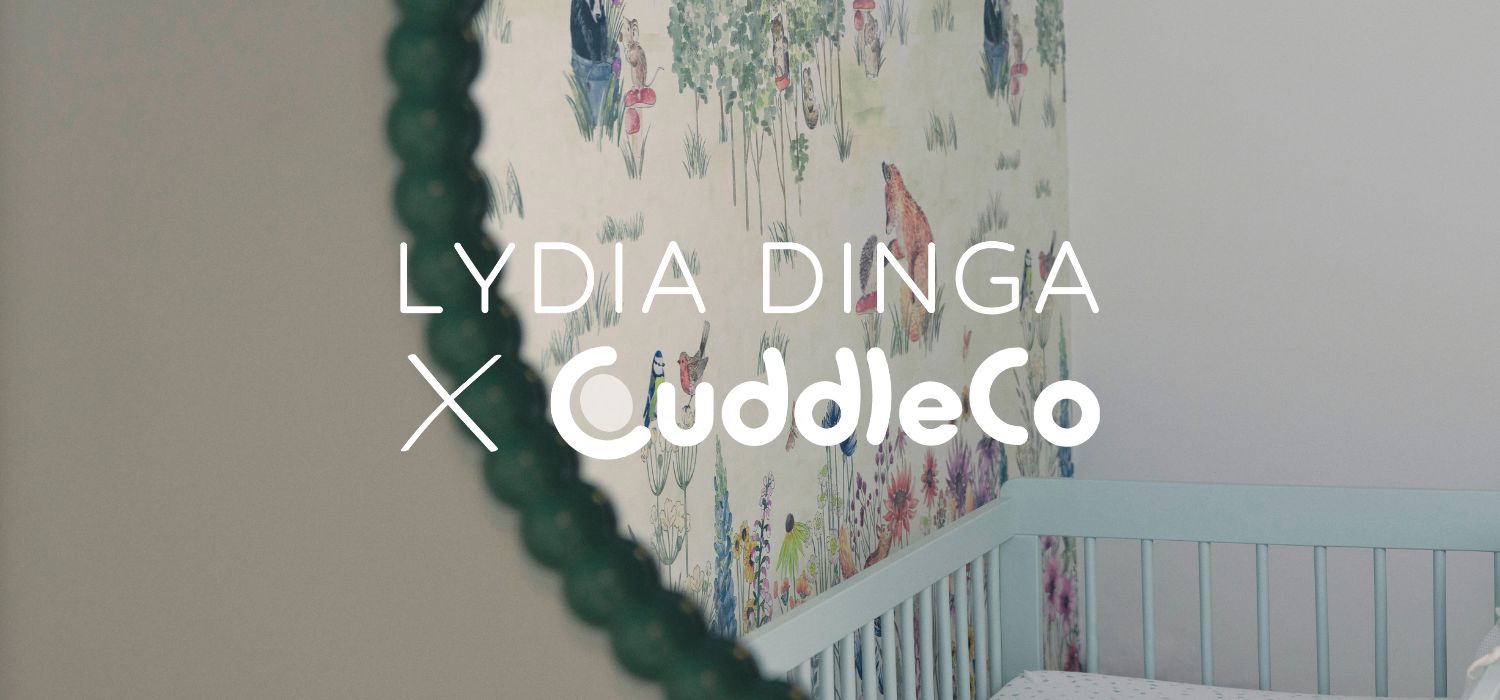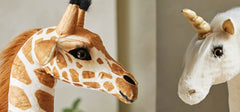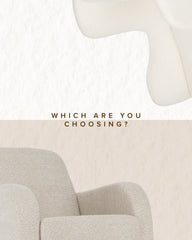Looking for something specific?
Take a look at our blog categories and get the advice and guidance you need!
Designing Nurseries
becoming a parent is one of the greatest things in life, but it can also be one of the scariest! the uncertainty of what parenthood will bring can spook anyone, but we hope to calm those nerves with a little advice from the experts.

At CuddleCo, our Nursery Essentials collection aims to make the nursery feel calm, comforting and stylish for modern family life. From playful cherries to timeless florals and tactile textures, our designs bring personality and practicality into everyday spaces.

Preparing your baby’s nursery is one of those special parts of pregnancy. From setting up the cot to folding tiny clothes, every detail helps you feel calmer, more organised, and ready for what’s ahead. That’s why we’ve created the CuddleCo Textiles Collection, a range designed to make nesting feel simple, supportive and beautifully coordinated.

Lydia Dinga’s nursery reveal has captured the attention of parents and interior lovers alike, inspiring a fresh wave of calm, peaceful, and timeless design in children’s spaces. Her timeless yet practical approach shows just how fun and creative nursery styling can be, proving the smallest of rooms can feel magical and inviting. As part of our collaboration, we sat down with Lydia to ask a few key questions, offering guidance and inspiration for parents planning a nursery of their own.

Designing a nursery is about so much more than choosing furniture, it’s about creating a space that feels calm, comforting and truly yours. That’s why we’re so excited to share this special collaboration with interiors enthusiast and lifestyle vlogger Lydia Dinga. Known for her bold yet soft approach to design, Lydia has styled her baby’s nursery with CuddleCo furniture that blends timeless style, everyday practicality and a touch of storybook magic. Here are her top picks to inspire your own nursery styling journey.

Discover how to style your nursery with timeless CuddleCo pieces. From the versatile Etta Chair and Clara Shelf to our cosy rattan storage and customer-favourite room sets, explore ideas that bring both style and practicality to your little one’s space.

Looking for nursery styling tips? UK interiors enthusiast Lydia Dinga shares 10 ways to design a calm, practical and stylish baby room. From choosing functional furniture to layering textures, adding personal touches and creating a soothing atmosphere, her advice helps new parents build a nursery that feels both beautiful and meaningful.

Within this blog, our expert visual merchandisers have put together a beautiful style guide packed with key accessories to help you bring your dream nursery to life. Whether you're starting from scratch or adding the finishing touches, this visual inspiration will help you create a warm, welcoming space that’s full of charm and personality.

The Easter bank holiday is the perfect time to slow down, nest, and create a beautiful nursery ready for your little one’s arrival. Whether you’re expecting your first baby or refreshing a space for a growing family, this weekend offers the perfect opportunity to transform your nursery into something truly special.

Here at CuddleCo, we understand that shopping for your baby’s mattress can be an overwhelming experience with the number of options out there. The technical vocabulary used to describe the different types of baby mattresses can make it hard to understand what’s best for your child.
The aim of this blog post is to break down the most important considerations when choosing a mattress for your little one and hopefully in return, make your mattress shopping experience less stressful.
Buying a mattress for your baby is most definitely not the most exciting or cutest purchase you’ll make in the run up to your little one’s arrival. But definitely one of the most important.
According to the NHS, most newborn babies are asleep more than they are awake and can sleep anything from 8 hours up to 18. So, ensuring they have a suitable mattress is essential.
The First 6 Months
For the first 6 months your baby should always be in the same room as you while they sleep. Most parents decide to purchase a bedside crib or moses basket for this reason, as they’re lightweight enough to move around the house. Some of these products may already come with a crib mattress, so you don’t have to buy one separately, like our Aria Crib. But be sure to check.
Transitioning From Crib to Cot Bed
Once your little one is ready to transition to their own room you will probably have purchased a cot or cot bed for them to sleep in. This is when you will need to upgrade their mattress. The size you need will depend on whether you need it to fit a cot or cot bed.
Most cots will require a 120 x 60cm mattress, and cot beds a 140 x 70cm mattress. However, we would recommend checking this is the case for the cot or cot bed you’ve purchased.
Important Things to Remember
One of the most important things to keep in mind when shopping for your baby’s mattress is to ensure that it’s the correct size for your baby’s crib, cot, or cot bed. Other key features to look for is that the mattress is firm, flat, and waterproof, as recommended by the Lullaby Trust.
Introducing CuddleCo Mattresses
All CuddleCo mattresses are designed and made in the UK with your baby in mind. Each mattress has a 2-in-1 cover where one side features a knitted bamboo material, made with naturally hypo-allergenic bamboo fibres, and the reverse is a waterproof training side.
The cover can be removed for easy cleaning in the washing machine, perfect for those unexpected accidents in the middle of the night.
Along with having potty training covered, CuddleCo mattresses are breathable to ensure your little one gets a restful night’s sleep.
The Difference Between Our Mattresses
When browsing our range of baby mattresses, you’ll notice a few key differences between each product:
- The mattress filling
- The mattress depth
- The price
Different Mattress Fillings
First up, is the filling of the mattress. This simply refers to what’s inside the mattress and whether it’s foam, sprung, or pocket sprung.
Foam Core
Hypo-allergenic, supportive foam ensures ultimate comfort for your little one.
Open Sprung
Hand-made open springs, crafted to deliver long-lasting support for your baby.
Pocket Sprung
Individual pocket springs contour to your baby’s body for maximum comfort and support.
Mattress Depth
All CuddleCo mattresses are maximum 10cm in depth to ensure your baby’s safety when used with any cot or cot bed. This helps to prevent them from climbing out as they get older.
Five Ways to Create the Perfect Sleep Environment for Your Baby
We spoke to Lynda Harding, Managing Director at Sweet Dreamers (the brand behind the ultimate baby sleep aid, ewan the dream sheep).
Lynda is a mum of six and inventor of the SweetDreamers product range and is passionate about transforming sleep time into a happy, safe and rewarding experience for all.
Here are her top five tips for creating the perfect sleep environment for your baby.
- Make sure your room is dark - use blackout blinds or blackout curtains
- Make sure the room is at a comfortable temperature. The ideal room temperature for safer sleep is between 16 - 20℃
- Make sure your baby is well fed, winded and has a clean nappy.
- Try some white noise to help create a calm sleep environment and to block out any unwanted sounds.
- Make sure your baby sleeps in the same room as you for at least the first 6 months for both day and night sleeps
More Information
For more information on safe sleep practices for your baby, head over to the Lullaby Trust, or speak to your Midwife who will be able to provide you with plenty of helpful resources.

The trend for gender-neutral nursery interiors has continued to grow over the last two years with celebrities such as Molly-Mae Hague opting for soft shades of beige and cream for their nursery colour scheme.
Whether you’re keeping the gender of your baby a surprise or simply want to create a nursery that will grow with them, a gender-neutral interior is perfect, and can easily be adapted to suit their personalities and interests as they get older with nursery wall art, soft textiles, and their favourite toys.
Design ideas and nursery themes
When planning the interior of your little one’s room you might want to consider a nursery theme. A theme can help steer the design of your nursery and give you inspiration for how you could decorate the room.
For example, safari is a fun, gender-neutral nursery theme that can easily be incorporated through stuffed animals and playful wall art. Other trending nursery themes you might want to consider are woodland and botanical themes which use colours and textures from nature.
Choosing gender-neutral nursery furniture
There are lots of different things to consider when shopping for nursery furniture such as how big your nursery is, whether you want a matching nursery set or just a cot bed, and of course the style and design of the furniture.
When creating a gender-neutral nursery you’re probably going to want to opt for a neutral colour palette. White is a popular option for nursery furniture as it can help make the room feel light and spacious, or if you prefer something with more depth a two-tone design like our bestselling Luna range could be the perfect option for you.
Nursery décor and accessories
Gender-neutral doesn’t have to be boring, look at it as a blank canvas for you to add your own personal touches through décor and accessories. Even the storage solutions you choose can add character to your nursery, like our adorable teddy bear baskets which are perfect for storing your baby’s toys.
Another thing to remember when designing your baby’s nursery is to create a space you’ll both be able to relax in. After all, both of you will be spending a lot of time together in the nursery. One item that’s sure to come in handy is a rocking nursing chair. It’s the perfect spot for you to bond, feed, and rock your little one to sleep. Our Etta Boucle Nursing Chair ticks all the boxes when looking for a comfortable but stylish nursery chair.
Other smaller additions like a printed changing mat, bookshelves and cot bedding can all contribute to creating the perfect gender-neutral nursery.

Deciding on a theme or a colour scheme for your nursery is a great place to start. This will impact what style of nursery furniture you choose and will guide you when looking for complementary accessories and décor.

You won’t be surprised to learn that having a baby comes with a lot of new “stuff”. It can be hard to work out which items are essential. Read on to discover the essentials.
check out our latest articles
Christmas Gift Guide: Thoughtful Gifts Under £50
Choosing Christmas gifts for babies, toddlers and expectant mums can feel overwhelming, especially when you want something practical, beautiful...
read moreWhy Convert Your Cot Bed into a Toddler Bed?
When you’re choosing nursery furniture, you want pieces that feel timeless and last beyond the baby stage. That’s exactly what a cot bed offers,...
read moreOne name, two sizes – what’s the difference?
We get this question a lot, so we've put together a simple guide to help you choose the right fit for your space. Parents often ask us about the di...
read moreGetting Ready for Baby: The New CuddleCo Nursery Essentials Collection
Preparing your baby’s nursery is one of those special parts of pregnancy. From setting up the cot to folding tiny clothes, every detail helps you...
read moreHow to Convert Your Cot Bed into a Toddler Bed
Turning your cot bed into a toddler bed marks an important moment in your child’s development - and with CuddleCo, it’s easy to do. (Applies...
read moreOur New Nursery Essentials Collection
The nursery is more than just a room, it’s where you and your baby will share so many firsts, from sleepy cuddles to playful mornings. The right...
read moreEtta vs. Marley: The Ultimate Nursing Chair Showdown
Spoiler alert: everyone wins (especially you and baby). When it comes to setting up your nursery, there’s one hero piece that often gets overlooked...
read moreA Sleep Solution That Grows With Your Family: Discover CuddleCo’s Cot Beds
Creating the perfect nursery is a beautiful part of preparing for a new arrival. From choosing calming colour palettes to picking out those first...
read moreMeet Shush Consultancy – Certified Child Sleep Consultant
Whether you're in the thick of sleepless nights or just looking to create healthy sleep habits, these gentle, practical suggestions are designed ...
read more













